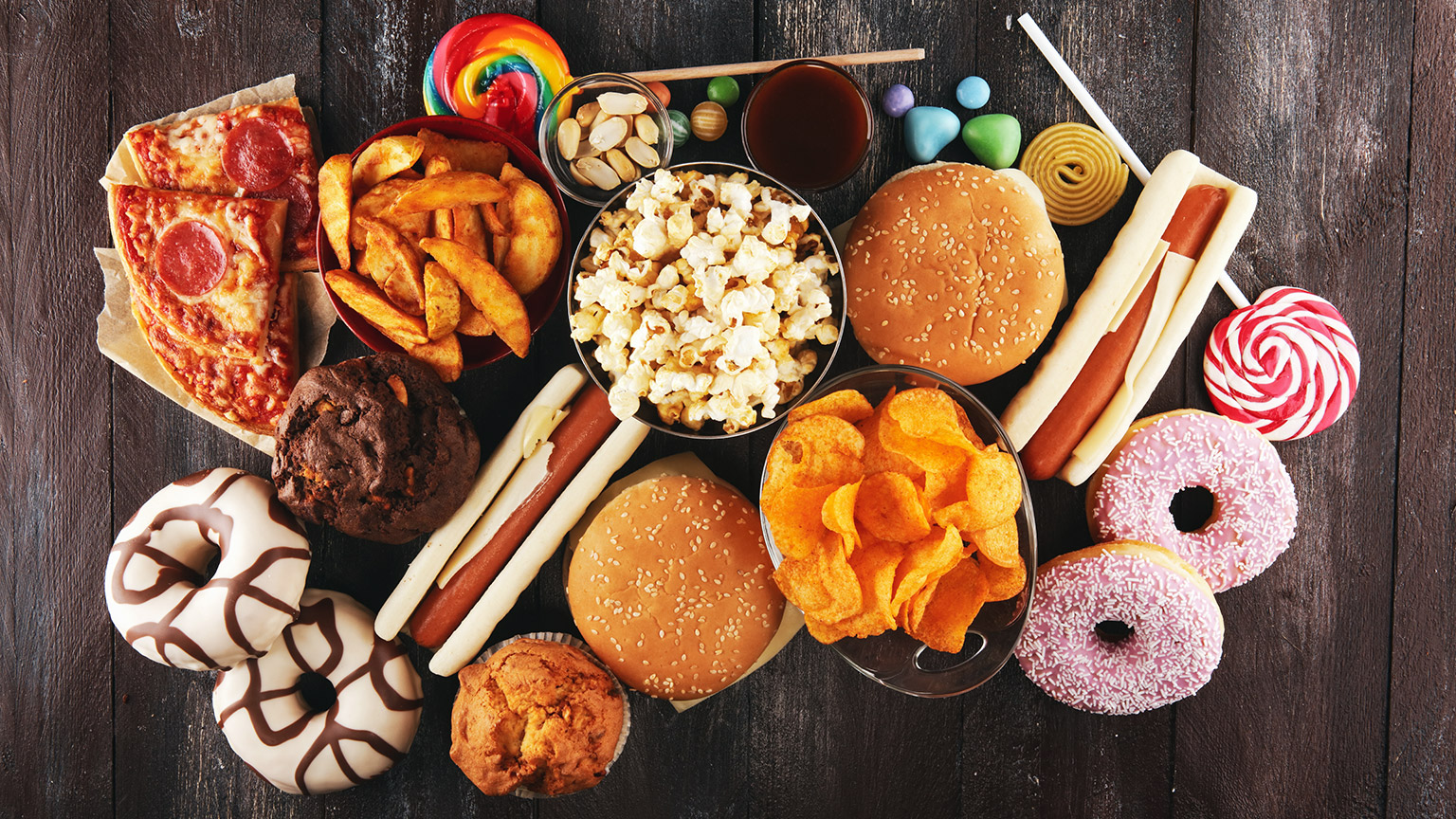In this topic, we focus on the role of fat and its influence in the human body within diet and exercise. You will learn:
- the structure and function of fat
- digestion, absorption, and storage
- fat needs and consumption
- fat and exercise
Terminology and vocabulary reference guide
As an allied health professional, you need to be familiar with terms associated with nutrition principles and use the terms correctly (and confidently) with clients, your colleagues, and other allied health professionals. You will be introduced to many terms and definitions. Add any unfamiliar terms to your own vocabulary reference guide.
Activities
There are activities and an automated quiz at the end of this topic. This is not part of your assessment but will provide practical experience that will help you in your work and help you prepare for your formal assessment.
Fat is the most abundant storage form of energy in the body!
Fat is also:
- an insulator
- a transporter and storage vessel for fat-soluble vitamins.
Fats are an essential macronutrient along with protein and carbohydrates with each gram of fat consumed providing the body with nine calories. Although there are some fats in foods we need to watch out for, there are other fats that come highly recommended to add as a part of a well-balanced diet. Before going into these different classifications of fats, let’s look below at what fats are made up of.
What are fats?
Fats are a part of a class of compounds known as lipids.
Lipids contain:
- triglycerides (stored form): the major components of fats and oils. They come in many forms and sizes, but all share the same common structure and is derived from glycerol with three fatty acids.
- fatty acids (simple form): a fatty acid is an organic acid consisting of a chain of carbon atoms with hydrogens and an acid group.
- phospholipids (cells): a type of lipid molecule that is the main structural component of the membrane of each of our body’s cells. Lipids are molecules that include fats, waxes, and some vitamins, amongst others. Each phospholipid is composed of two fatty acids, one phosphate group, and a glycerol molecule.
- sterols: this helps sustain the structure of a cell membrane.
- cholesterol (fat in the blood): a waxy substance found within the blood, required by the body to build healthy cells, however, elevated cholesterol levels can impact our health due to the fatty deposits found within the blood, leading to issues such as heart disease.
- lipoproteins: named due to their structure of lipid (fat) and protein. Their role is to transport cholesterol (fat in blood) through the bloodstream and cellular fluid.
Fats are organic compounds made up of carbon, hydrogen and oxygen. If you are wondering why this looks familiar, it is because it is the exact same composition of carbohydrates (CHO) with the difference being the proportion of hydrogen to oxygen.
Let’s learn more about fat types and their structures in the following 4-5 minute video.
Types of Fats
As we saw in the video, Glycerol molecules are all the same and act as the backbone that holds all the molecules together, however, fatty acids vary in chain length and degree of saturation. It is these differences in the structure which determine whether a fat is “saturated” or “unsaturated”.
There are four types of fats found in foods, some of which are more beneficial to the health of the human body than others. Each of these fats is derived from a different source of foods and some of the wrong kinds of fats, in excess can cause serious health conditions.
Let’s have a look at each type of fat below.
Saturated Fat
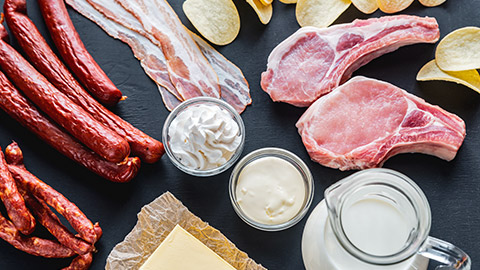
These are loaded with all the H+ atoms they can carry (single bonds), for example, stearic acid (soap). Certain saturated fats are known to increase total blood cholesterol and low-density lipoprotein (LDL) cholesterol, which can lead to atherosclerosis (narrowing of arteries) and coronary heart disease.
Though the main food that contains saturated fats are derived from animal products such as lard, eggs, or dairy products such as butter, cheese and full-fat milk. You will also find high amounts in other food sources such as coconut oils. Meat fats are a mixture of all fatty acids but are predominantly saturated and monounsaturated.
Saturated fats are typically solid at room temperature, so are easy to spot and dispose of. A good example of this is lard. The texture of saturated fats has a smooth waxy like substance important in cell membranes and stored in the adrenal glands, ovaries, and testes where it is used to make adrenaline and steroid hormones. Surplus cholesterol in the blood is often deposited on the artery walls (plaque) leading to narrowing of the arteries, angina, heart attacks, and stroke. Health issues regarding Cholesterol is highly linked to high amounts of saturated fats consumed as much cholesterol is found in many foods of animal origin and rarely in plants.
Let’s pause and take a minute ( literally) to watch the following video on cholesterol and the potential impact of its presence.
Monounsaturated Fats
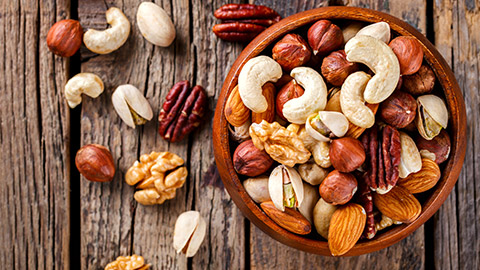
Monounsaturated fats’ (mono ~ = one) structure has one double-bonded carbon molecule (an unsaturated carbon atom) with the remaining carbon atoms being single-bonded, for example, oleic acid. Plant foods, on the other hand, and seafood are usually a mix of mono- and polyunsaturated fats.
These are known as “good fats”, monounsaturated fats lower low-density lipoprotein (LDL) blood cholesterol (bad) but not high-density lipoprotein (HDL)’s (good), thus reducing cardiovascular disease (CVD) risk factors. HDL cholesterol actively works to remove cholesterol build up in arteries. Research has shown monounsaturated fats to have health benefits related to weight loss, reducing the risk of heart disease and also decrease inflammation.
Best sources of monounsaturated fats are:
- olive oil (75% mono)
- canola oil
- nuts - macadamia, pistachios, hazelnuts, and almonds among the highest sources
- avocado oil.
Polyunsaturated Fats

Polyunsaturated fats (poly~= many) have more than one double bond and contain essential fatty acids that the body needs but cannot produce. Polyunsaturated fats can be divided into the following 2 fatty acids;
- omega-6 e.g linoleic acid
- omega-3 e.g. and alpha-linoleic acid.
Omega -6 food examples:
- sunflower seeds
- soybean products
- corn oil.
Omega -3 food examples:
- oily fish (fish oil)
- soybean
- mustard
- walnuts
- canola and linseed (flax) oils.
Trans Fats
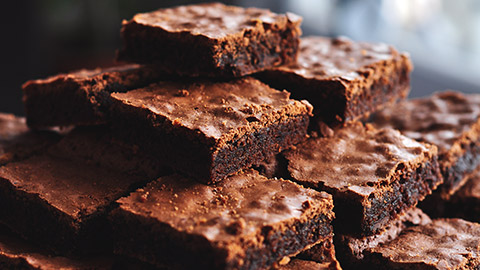
Trans fats are arguably the worst type of fat. Trans fats are fundamentally the result of hydrogenation of vegetable oils. This is a process used in many kinds of margarine and shortening products (butter, lard, vegetable oils, and margarine). These products are typically used in most baked products in order to increase the pliability of the dough. Fats are also produced in small amounts during the deep-frying process and occur naturally in some foods such as butter. While technically they are not viewed as being saturated fats, they do cause many of the same effects on the human body and when eaten in excess, it can cause serious health complications. Most baking and convenience foods such as potato chips have some trans fats.
This would be a good time to pause and recap on the information above, there is a lot to take in, however, this is hugely valuable information to become comfortable with as being able to provide nutritional guidance to your clients will see you above the rest of the fitness professionals, providing a full and informative service to ensure your client goals are met effectively.
Take a look at the following 4-minute video below that discusses the differences between fat types and looks at trans fats in a little more depth, making sure to document any terms you are not yet familiar with in your terminology and reference guide for future reference.
Below are some examples and sources of each different types of fat and how they react in the human body.
Harmful dietary fat
| Fat type | Saturated fat | Trans fat |
|---|---|---|
| Effects on the body | Raises total blood cholesterol levels and LDL cholesterol levels | Raises LDL cholesterol and lowers high-density lipoprotein (HDL) cholesterol |
| Dietary Sources | Animal sources of foods | Present naturally at low levels in some food. Also in partially hydrogenated oils |
| Examples of foods | Fatty cuts of meats, sausages, ghee, butter, cheese, pastries, full-cream dairy products, coconut milk/oil, palm kernel oil | Hydrogenated vegetable oil, shortenings, pies and pastries, commercial cakes and biscuits, deep-fried foods |
Healthier dietary fat
| Fat type | Monounsaturated fatty acids | Polyunsaturated fatty acids (especially omega-3 fatty acids) |
|---|---|---|
| Effects on the body | Maintains HDL cholesterol level while reducing the levels of LDL cholesterol | Lowers the level of LDL cholesterol |
| Dietary Sources | Found in a variety of food and oils | Oily fish and plants |
| Examples of foods | Vegetable oils (eg, olive oil, safflower oil, peanut oil, corn oil, rapeseed oil, canola oil), nuts (eg, hazelnuts, almonds, cashew nuts, Brazil nuts, peanuts), avocados | Fish: Salmon, tuna, trout, mackerel, sardines, herring. Plant: Flaxseed (ground and oils), soybean oils, walnuts, butternuts, sunflower seeds |
Fun Fact
An average, size 10, slim female carries approximately 100,000 calories of fat on her body!
A male with single-digit body fat % still has 30,000 calories of fat on board!
Digestion
Digestion is a process of which when food is consumed, broken down in the digestive organs, absorbed by the body then excreted. Within the mouth, mastication (chewing) and saliva commence the process of digesting the food consumed. Once swallowed, the body begins to break down the food, and it absorbs its’ nutrients. The stomach, the small intestine, and the large intestine play an active role when digesting fat.
Let’s take a look at the function of those three organs to have an understanding of what happens to fat through digestion.
- Stomach: the stomach has a churning action (peristalsis) that mixes the fat, water and acid.
- Small Intestine: The majority of digestion and absorption of fats occurs within the small intestine. The pancreas produces enzymes and the liver produces bile where they are delivered to the small intestine and contribute in breaking down the fat. The bile will help emulsify the fat and the enzymes will support in digesting the fat.
- Large Intestine: fat and cholesterol trapped in fibre exit in solid waste through the large intestine. Approximately 5% of fat gets excreted while the remaining 95% gets absorbed and stored.
The following image shows the process of digestion of fat within the body.
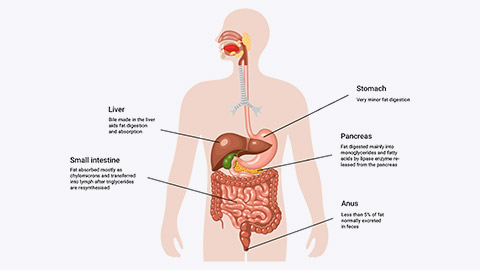
Absorption
Once the enzymes and bile digest and emulsify the fat into monoglycerides and free fatty acids, they get transported to the cell walls of the small intestine where they are absorbed and transformed into particles named chylomicrons (small fat molecules). Because these are still slightly too large a molecule to enter straight into the bloodstream, they first travel to the lymphatic system. Once then in the bloodstream, they are distributed around the body, such as to the liver and body tissues to be used or stored for energy, cell repair, and growth, with excess fatty deposits being stored in the adipose tissue (Body fat).
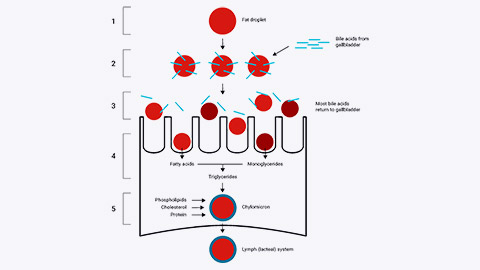
- Stage 1: large fat droplets enter small intestine after meal
- Stage 2: bile acids and lecithin emulsify fats into smaller particles, especially the bile acids
- Stage 3: lipase breaks down fat into fatty acids and monoglycerides
- Stage 4: monoglycerides and fatty acids are absorbed through villi via micelles and then re-form into tryglycerides
- Stage 5: triglycerides aggregate and are combined with cholesterol, protein and phospholipids to form chylomicrons.
Storage
Fat storage occurs in the subcutaneous adipose layer of the skin (fat under the skin) and visceral deposits (around vital organs). It can also be found in muscle as intramuscular triglyceride and acts as structural components for a variety of cells. Storage of excess fatty tissue around our vital organs can cause these organs to work harder in order to perform their functions which can cause difficulties and lead to increased risks of disease states and conditions such as diabetes mellitus, cardiovascular disease, liver, and kidney functioning just to name a few, therefor, it is important, from a health point of view, that we maintain an optimal level of body fat storage.

Macronutrient guidelines
General dietary recommendations for total daily fat consumption suggests that a healthy adult should have a total fat intake of up to 30% (and to include a mix of fat types). Saturated fats and trans fats are recommended to be 10% or less. Targets for monounsaturated fats are recommended to stick between 10-20% and polyunsaturated fats 6-12%.
FUN FACT: 1 gram of fat = 9 calories
Let’s take a look at the macronutrient guidelines below:
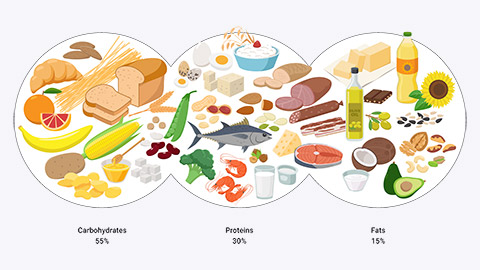
New Zealand Statistics
The average fat intake for New Zealand is 33% which is slightly above the recommended amount. The average daily intake for men was 95g and for women was 67g with its principle sources of fat deriving from the following:
- Butter and margarine (16%)
- Potatoes/kumara cooked in fat or oil, beef, veal, milk, cakes and muffins (all 6%)
- Pies and pastries, bread-based dishes (sandwiches incl), sausages and processed meats (all 5%)
Fat added to food in the forms of sauces, butter etc contributes 25% of total fat intake. Butter and Margarine contribute 44% of that figure.
This information highlights the need to include this information in any dietary consultations you have with your clients in order to share what you have learned and guide your clients appropriately for a healthy balance of fat intake, and of course, to aid them in achieving their goals.
Diets and fat
Fat consumption for weight loss
Most active people can maintain body-fat working on a recommended intake of 1g per Kg of body weight. e.g. An 85Kg male could have up to 85g fat per training day. Of course, if body fat reduction were a goal, this could be decreased by 15%. Easiest done by using 0.85g x Kg.
Let’s take a look below at how fat can be integrated into a weight loss diet.

Fat can absolutely be part of a weight-loss diet! In fact, the ketogenic diet suggests that 75% of daily food intake should come from fat! Yup, you heard correctly! You can eat predominantly fat and still lose weight. The key is eating the right types of fat (mainly monos and polys) and ensure a total calorie deficit is maintained ( energy in versus energy out). Because fat has double the calorie density of other macronutrients if too much fat is eaten (even good fat) calories will climb quickly, but if done correctly, weight loss can most certainly be achieved.
Issues with a high-fat diet
A popular diet that can bring on serious health complications is the high-fat diet, where common foods such as meats, cheeses, and butter consumed in excess and regularly may come with consequences to the health of individuals. The key to reducing the bad effects of eating too much saturated and trans fats is to eat “good” fats instead.
See the below health conditions to see what could happen to the human body when a person eats a high-fat diet regularly.
- Obesity: There is a definite and strong link between excess fat intake and obesity.
- Hypertension: Due to an increase in peripheral resistance in response to fatty deposits on blood vessel walls blood pressure can be negatively affected, resulting in an increased resting blood pressure level.
- Heart disease: High intakes of cholesterol (mainly from saturated fats) causes a waxy like substance to build up in the arteries, causing the wall of the arteries to thicken, effectively reducing the space available for blood to flow through, therefore also increasing blood pressure and increasing the demand on the heart.
Newer research suggests high sugar intakes can also elevate blood triglycerides adding to health issues and the thickening of the blood.
FUN FACT: Omega 3 fatty acids actively lower blood cholesterol levels and reduce the tendency of the blood to clot.
Issues with a low-fat diet
Low-fat diets have been associated with healthier body weights. However, it is important to be mindful of many low-fat processed items, as they can contain a lot of sugar or other refined carbohydrates. Just because something is low in fat, doesn't mean it’s healthy, nutritious or low in calories. It is also important to be aware that vitamins A,D,E and K are fat-soluble vitamins and essential to a nutritious diet. They are most often found in fat-containing foods therefore if fat is cut from the diet, these vitamins might not be absorbed in required amounts leading to deficiencies.
Fast food
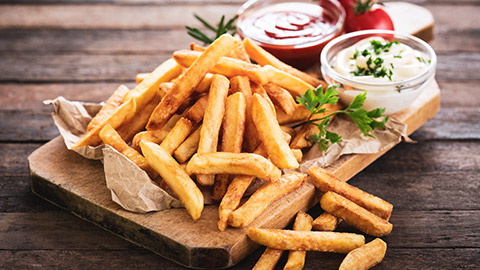
Fast food is extremely calorie-dense. The number of calories in an average fast food meal outweighs a normal home-cooked meal. For instance, a normal-sized home-cooked meal with 100-200g of lean meat and 3 vegetable serves would have around 450-600 calories in total. Check out the calorie values of fast food nutrition labels and take note that, the fast food meal would normally have around triple the calories of the home-cooked meal! The fat values of the meals are also well over the daily amount of fat for most people (74g and 103g). This is where most of the calories are coming from, along with sugar and refined grains.
FUN FACT: 450g of body fat is equal to 3,500 calories. To burn 3,500 calories the average person would need to walk briskly for almost 9 hours or jog for 6 hours. Unfortunately burning 3500 calories in exercise doesn't mean you will lose a pound of fat. The body stores around 2000 calories of carbohydrates, and much of this will be used to fuel the exercise.
Calculating calorie content of fat on labels
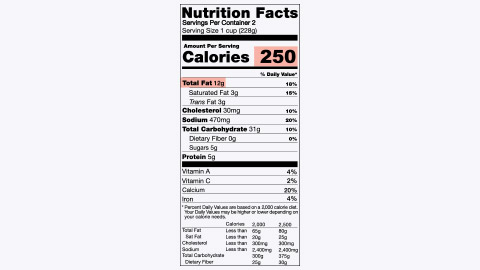
Let's take a look at nutritional labels found on food products and calculate the percentage of calories gained from fat for a standard serving/portion size.
Review and practice the steps below, using the labels above, to calculate the percentage calorie contribution from fats, once you are comfortable with the steps below, have a look at labels around your home and see if there are any surprises in your cupboard.
Important! When reading a nutritional label it is important to be aware that each nutrition label indicates a serving size therefore be mindful of the serving size versus container size per container (unless it is Nutella or Ben n Jerry’s -ha!)
Step1: Determine calories per serving eg. 250 calories
Step 2: Determine the grams of total fat eg. 12 grams/serve
Step 3: Calculate total calorie intake from fat (REMEMBER: there are 9 calories in a gram of fat)
=12g x 9 calories/gram
Total calories from fat = 108 calories
Step 4: calculate the percentage intake of calories from fat
=(Total calories from fat ÷ calories per serving x 100)
=(108 ÷ 250 x 100 = 43.2)
Percentage intake of calories from fat= 43.2%
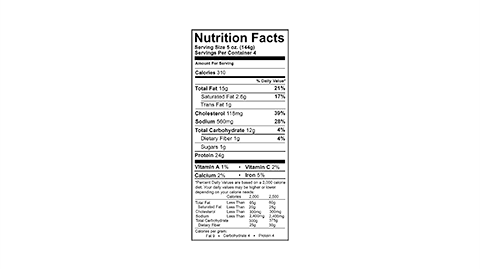

Fat has most of the body’s stored energy, providing more than half of the energy required by the body, even more than carbohydrates or proteins, which is why your body keeps fat in reserve. The more free fatty acids (FFA’s) that are released from adipose tissue (fatty tissue) into blood, the more fat will be used by the muscles. As the exercise becomes increasingly prolonged, fat usage increases (as does carbohydrate). The more trained a muscle is, the greater is its ability to use fat as fuel, therefore, exercise does increase our ability to utilise fat as a fuel. Fat metabolism requires a continuous supply of oxygen, that is why fat is mostly burned during aerobic exercise.
See a comparison below of two different types of exercises and how they each utilise different amounts of energy from fats and CHO.
Walking: burns 60% fat with 40% coming from Carbohydrates (CHO)
Running (10 km/hr): burns 30% fat and 70% Carbohydrates (CHO).
This does not necessarily mean that more fat is burnt by walking than by running, it does, however, highlight that the intensity of exercise does influence fat use as a fuel, but the total amount of calories burned is also important. Running burns more total calories, so even if less fat is burned as a percentage of fuel more total fat calories could still be burned than walking. While walking burns more fat as a percentage of fuel, running burns more total calories and for that reason, it burns more total fat calories. See the following example for 20 minutes of exercise:
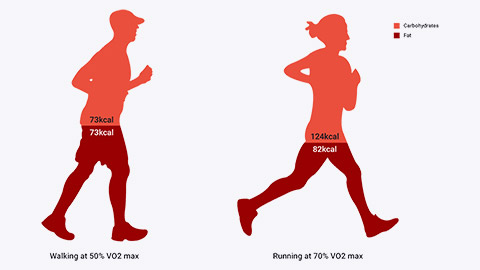
Fitness and fat as a fuel source
Fats should be consumed sparingly prior to exercise of any intensity due to little chance of depletion and slow absorption. Fat is slow to digest and therefore cannot be “refueled” during an event. The storage of fat in our muscles does provide a source of energy, however, it is generally used in conjunction with Carbohydrates (CHO).
It is suggested to eat in small portions throughout the day, but avoid fat in the lead up to, during, and immediately after exercise. This is for the reason that fat will slow the absorption of other nutrients that are needed in the pre-exercise window, for instance, carbohydrates (CHO). It will also blunt the insulin response post-training interfering with muscle replenishment of CHO and protein absorption.
FUN FACT: Fat is used differently during exercise for people that are fit and those that are unfit. When an individual is fit, their body is well-equipped to utilise fat as a fuel source.
In this topic, we focused on the role of fat and its influence on the human body within diet and exercise. You learned about:
- The structure and function of fat
- digestion, absorption, and storage
- fat needs and consumption
- fat and exercise
